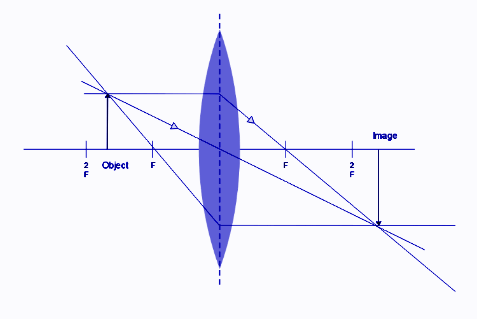
The image of a convex lens depends upon the distance of the object from the lens.
(A) True
(B) False
Answer
492k+ views
Hint:
To find out the relation between the object and image of a convex lens, we need to know about the positions of the object and the image formed on the other side of the lens. First, we need to study the image formation by a convex lens.
Complete step by step answer:
Image formation takes place when light rays from an object pass through a lens. A convex lens forms an image by refracting light rays. The light rays from an object pass through the lens, get refracted and meet at a point to form an image.
We observe this by drawing ray diagrams by following the three rules of refraction for a convex lens,
- An incident ray parallel to the axis refracts through the lens and passes through the principal focus on the other side.
- An incident ray passing through the principal focus refracts through the lens and travels parallel to the axis.
- An incident ray passing through the centre of the lens carries on in the same direction.
By applying these rules, let us draw ray diagrams to find out the relation between the image and the object.

Here, we can see that the object is placed between F and 2F and the image is formed beyond 2F. The size of the image is greater than the size of the object. It is because of the magnification of the lens. The magnification is given by the ratio of the image distance by the object distance.
Where,
m is the magnification of the lens,
v is the image distance and u is the object distance.
Hence, the distance between the object and the lens influences the size of the image.
Thus, the correct answer is option (A).
Note:
While drawing the ray diagrams, keep in mind about the position of object and the rays from the object. It influences the formation and position of the image. We should keep in mind about the number of rays coming out of the object and the rays that converge to form the image.
To find out the relation between the object and image of a convex lens, we need to know about the positions of the object and the image formed on the other side of the lens. First, we need to study the image formation by a convex lens.
Complete step by step answer:
Image formation takes place when light rays from an object pass through a lens. A convex lens forms an image by refracting light rays. The light rays from an object pass through the lens, get refracted and meet at a point to form an image.
We observe this by drawing ray diagrams by following the three rules of refraction for a convex lens,
- An incident ray parallel to the axis refracts through the lens and passes through the principal focus on the other side.
- An incident ray passing through the principal focus refracts through the lens and travels parallel to the axis.
- An incident ray passing through the centre of the lens carries on in the same direction.
By applying these rules, let us draw ray diagrams to find out the relation between the image and the object.

Here, we can see that the object is placed between F and 2F and the image is formed beyond 2F. The size of the image is greater than the size of the object. It is because of the magnification of the lens. The magnification is given by the ratio of the image distance by the object distance.
Where,
m is the magnification of the lens,
v is the image distance and u is the object distance.
Hence, the distance between the object and the lens influences the size of the image.
Thus, the correct answer is option (A).
Note:
While drawing the ray diagrams, keep in mind about the position of object and the rays from the object. It influences the formation and position of the image. We should keep in mind about the number of rays coming out of the object and the rays that converge to form the image.
Recently Updated Pages
Master Class 12 Business Studies: Engaging Questions & Answers for Success

Master Class 12 English: Engaging Questions & Answers for Success

Master Class 12 Social Science: Engaging Questions & Answers for Success

Master Class 12 Chemistry: Engaging Questions & Answers for Success

Class 12 Question and Answer - Your Ultimate Solutions Guide

Master Class 11 Economics: Engaging Questions & Answers for Success

Trending doubts
Draw a labelled sketch of the human eye class 12 physics CBSE

a Tabulate the differences in the characteristics of class 12 chemistry CBSE

Which one of the following is a true fish A Jellyfish class 12 biology CBSE

Why is the cell called the structural and functional class 12 biology CBSE

Differentiate between homogeneous and heterogeneous class 12 chemistry CBSE

Write the difference between solid liquid and gas class 12 chemistry CBSE




